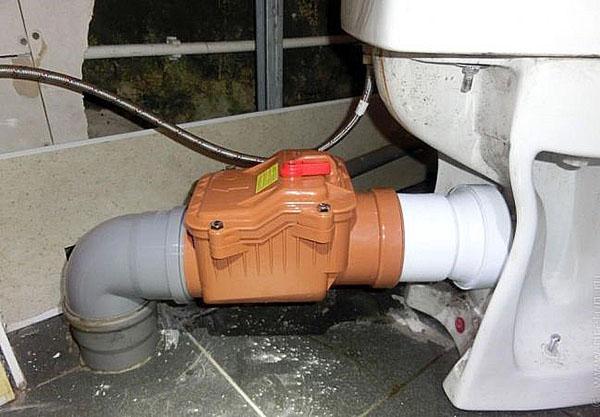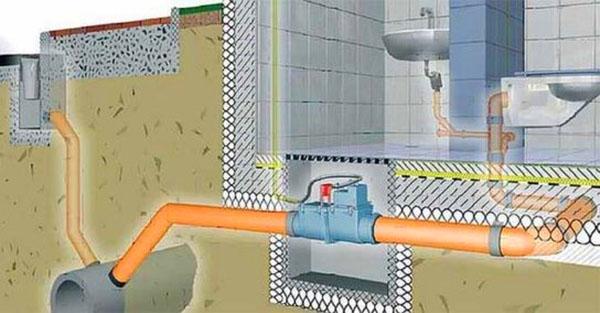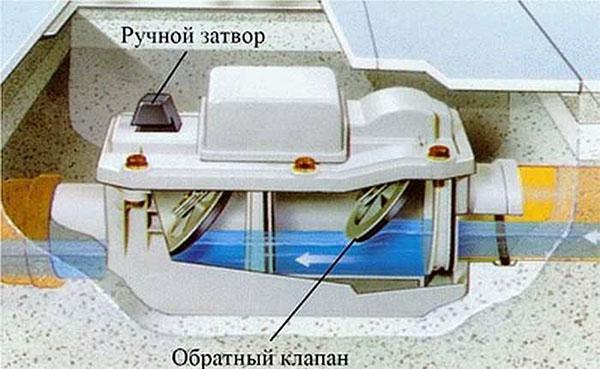How to choose and install a sewage check valve
 An accident in the sewer system may become the reason for unscheduled repairs in the apartment. To avoid unpleasant moments, specialists have developed a check valve for the sewage system. On what principle the device works, and how to choose the required limiter, read on.
An accident in the sewer system may become the reason for unscheduled repairs in the apartment. To avoid unpleasant moments, specialists have developed a check valve for the sewage system. On what principle the device works, and how to choose the required limiter, read on.
Causes of blockages

There can be several reasons for clogged sewer ducts:
- Violation of the rules for operating the sewage system, as a result of which rags, plastic bags, personal hygiene products and more get into the pipes.
- Sediment on the pipe walls as a result of prolonged operation without proper maintenance. The sediment partially blocks the lumen, making it difficult for the water to move. As a result, the solids settle much faster, causing blockages.
- Incorrect slope of the sewer pipes. The cause of the blockage can be either too small or, on the contrary, too great a slope. In order to avoid clogging, the water through the sewer channel must move at a certain speed, changing the slope of the pipes, you can change the entire system.
- The presence of bends that have right angles in the structure can dramatically change the flow rate of the waste water, which will further lead to blockage of the site.
Sewer blockages are unavoidable, but their likelihood can be minimized simply by following the rules of operation and installation.
Types of devices
The choice of material from which the check valve used in the sewage system will be made depends on the pipes that are installed on the site. For the check valve, stainless steel, bronze or brass, cast iron or plastic are used.
In addition to the material, the device of the device can also be different. The check valve device consists of:
- inlet and outlet branch pipes;
- lever for self-discharge of drains;
- membrane to shut off the pipeline;
- clog cleaning cover.
The principle of operation of the sewage check valve is to block the return flow of waste water.
The types and methods of valve fastening may vary. The following types are distinguished:
- interflanged;
- ball;
- swivel;
- lifting.
To choose the right sanitary valve, you need to know the benefits of each.
Interflanged
 These valves are small and lightweight. Installing a wafer check valve does not include a flange connecting it to the water pipe. If failures in the device system are detected, the valve itself and a small section of the sewer system to which it was attached will have to be replaced.
These valves are small and lightweight. Installing a wafer check valve does not include a flange connecting it to the water pipe. If failures in the device system are detected, the valve itself and a small section of the sewer system to which it was attached will have to be replaced.
Such valves can be of two types:
- Spring-loaded disc. In such devices, the spring acts as a lever, and the disc replaces the membrane.
- Bivalve. The diaphragm in these valves has two flaps.
Rotary valves
D Another name for the species is petal. The membrane in such devices is a spool or slam, operating with a lever.
Another name for the species is petal. The membrane in such devices is a spool or slam, operating with a lever.
Such valves can be:
- Simple. They are used in systems with low pressure and the amount of liquid to pass through. When the spool returns to its original point, a strong blow is obtained that can ruin the systems.
- Unstressed. A safer device in which the spool slides back into place.
Ball valves
 The ball check valve for sewage has the most simplified system of action.Such a valve is very reliable, and replacing the device is not difficult - just unscrew the two bolts. Instead of a membrane, a metal ball is used, and a spring serves as a lever. These valves are very popular due to their ease of operation.
The ball check valve for sewage has the most simplified system of action.Such a valve is very reliable, and replacing the device is not difficult - just unscrew the two bolts. Instead of a membrane, a metal ball is used, and a spring serves as a lever. These valves are very popular due to their ease of operation.
Lift valves
 The membrane in such a device is a lifting mechanism of a return action. The main advantage is the ability to carry out repairs without disassembling the network, and the main disadvantage is exposure to pollution.
The membrane in such a device is a lifting mechanism of a return action. The main advantage is the ability to carry out repairs without disassembling the network, and the main disadvantage is exposure to pollution.
Lift valves can be divided according to the method of attachment to sewer pipes:
- Pipe welded (built-in check valves).
- Devices that are installed using connecting flanges.
- Screwed-in products on the thread.
- Wafer valves.
How to choose a check valve for sewage
Before purchasing a sewer valve for personal use, it is necessary to carefully analyze the features of the system. The type of device used depends on the specifics of the sewage system.
When choosing the best option, you must refer to the following parameters:
- The diameter of the sockets must match the cross-sectional diameter of the pipes. Do not take valves of a larger or smaller diameter with special adapters - this can worsen the well-established drainage system and disrupt the throughput of drainpipes.
- Material. It is worth choosing valves made of the same material as the pipes. It can be plastic, cast iron or steel.
- Device size. It is worth paying attention to the place where it will be installed. It is important that the maintenance of the sewage check valve is not difficult, therefore, access to it must be free.
- Complexity of installation. If the installation of a check valve on the sewer is difficult, then it is better to seek professional help, but if this is a simple model, then you can do it yourself.
- Quality and guarantee. When choosing a device, pay attention to the workmanship: nothing should dangle or creak under your hands. An arrow indicating the direction of the wastewater is required. Responsible manufacturers thus eliminate possible installation errors.
Sizes and types of sewer valves
The material from which the valve is made is selected taking into account the pipes used in the drainage system.
When choosing a device, you need to pay attention to its features and size. Let's consider several options:
- Valves made of PVC or plastic are the most popular option for installation in modern sewerage system, the pipes of which are made of polyvinyl chloride. When trying to install a non-return valve on a plastic toilet for a cast iron or steel system, you must use special adapters.
- Metal devices are suitable for both cast iron and steel installations. They are equipped with special pads and secure fasteners. A sewer check valve 110 is used for a toilet, a smaller diameter - they drain water from the bathroom and sink.
- Both vertical and horizontal valves are used to drain wastewater from washing machines and sinks. A sewage check valve with a diameter of 50 mm is suitable for these purposes. To drain waste from the toilet bowl and bathtub, I use a horizontal arrangement of valves. Their diameter can vary from 50 to 160 mm, depending on the diameter of the pipes of the entire system.

If there is not enough free space to clean the blockage from the blockage, a vertical drain check valve can be used.
In order for the sewerage shut-off device to function without failures, it is necessary to select the right check valve, following the instructions set out above. It is important that the diameter of the pipes and the device coincide - this has a positive effect on its operation.
If you are not sure that you can independently install the system, you should contact a professional plumber.
Locking device installation rules
 The shut-off valve is installed both during the assembly of the pipeline system at the pipe connection point, and in an existing system.
The shut-off valve is installed both during the assembly of the pipeline system at the pipe connection point, and in an existing system.
The valve used in the system must be of the same diameter as the pipes. This will allow the system to function properly.
The main thing to consider during installation is the direction of the wastewater, it is indicated by an arrow on the valve. Features of installing a check valve on the sewer:
- For a plastic sewer pipe, the valve is installed in a standard way: the straight edge of the pipe is inserted into the existing socket, and the sealing rubber makes the connection tight. To enhance the effect, you can treat the connection with sanitary silicone.
- Cast iron valves are installed using gum and bolts that tighten the plates. Models with sockets are less common.
- The locking device is installed in such a way that access to the cover remains free. This makes it easier to clean the valve in the event of a blockage.